Trustees Consider New Proposal For Stormwater Improvement Plan at Harcourt Woods
- Details
- Hits: 3528
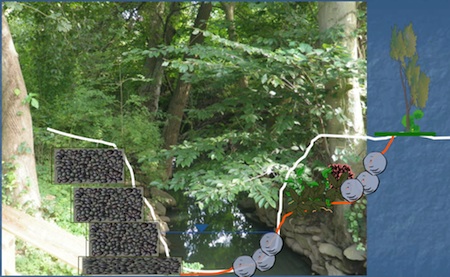 Now that the storm water improvement projects at George Field and Cooper Green nears completion, the Scarsdale Board of Trustees is moving their focus downstream to Harcourt Woods below Scarsdale High School. On Wednesday June 5th, the Board of Trustees met once again with Robert DeGiorgio of Dvirka and Bartilucci Engineers to discuss a revised plan to improve storm water management in the South Fox Meadow Area, namely Harcourt Woods.
Now that the storm water improvement projects at George Field and Cooper Green nears completion, the Scarsdale Board of Trustees is moving their focus downstream to Harcourt Woods below Scarsdale High School. On Wednesday June 5th, the Board of Trustees met once again with Robert DeGiorgio of Dvirka and Bartilucci Engineers to discuss a revised plan to improve storm water management in the South Fox Meadow Area, namely Harcourt Woods.
Harcourt Woods, the wooded area adjacent to the high school and north of Scout Field, is the seventh and final segment of a comprehensive storm water management plan for the South Fox Meadow area of Scarsdale. The other six segments include George Field Park, Cambridge Road, Cooper Green, Post Road, Murray Hill and the gravel parking lot at the High School. Each of these segments has been deemed a strategic area and has undergone alterations to facilitate excess storm water. George Field Park and Cooper Green have been transformed into dry detention basins that store water in order to protect against flooding and erosion. The open watercourse along Post Road is being de-silted and re-channelized to help eliminate the bottleneck and reduce overall peak flows. As is evident, each of the seven segments requires individual maintenance and plans to improve water flow in Harcourt Woods are now in the works.
The goals of this project are:
-Sediment and erosion control
-Storm water conveyance
-Erosion protection for Scout Field and the high school tennis courts
-Improvement of water quality
-Management of invasive plants.
To fulfill these goals, D &B has devised a comprehensive plan to de-silt the watercourse, install a sediment trap, create a Gabion Wall, install a maintenance access trail, divert the storm water away from Brewster Road remove some trees and plant others.
A key aspect of this project is the creation of a sediment trap. A sediment trap is a device installed to capture eroded soil that is washed off during a rainstorm. This trap will remove sediment and debris from Brewster Road before it reaches South Fox Meadow and thus protect the water quality of nearby streams and ponds. The sediment trap is not the sole modification to Brewster Road which will also have up to 1,100 feet of new catch basins and rain piping and 900 feet of curbing and walkway additions. The curbing on Brewster Road will improve the flow of water at the high school by capturing water and stopping it from entering the HS parking lot. "It is not going to be a 100% solution for the parking lot, but will be an enormous improvement," said DeGiorgio. These changes will lead to more efficient water capture, improved water quality, and most importantly, reduce flows to the South Fox Meadow Brook.
DeGiorgio explained that the Fox Meadow Brook now meanders through Harcourt Woods in a hooked path that may have been diverted at an earlier time. The current stream bank encroaches on Scout Field and borders the high school tennis courts. The stream bank is eroding and there are many dead and dying trees in Harcourt Woods, which at some points obstruct the watercourse.
"Erosion control is also critical to keeping sediment out of the system," says Rob DeGiorgio. It is especially important to mitigate erosion along the Fox Meadow Brook because it deteriorates the stream banks, allowing for water to overflow and excess sediment to deposit in the brook. According to Rob DeGiorgio, this sediment is "the number one pollutant" and yields an overall poorer water quality in the watercourse.
To restore the stream bank and remedy erosion, D & B will install an 800-foot Gabion Wall along the banks of the Fox Meadow Brook. 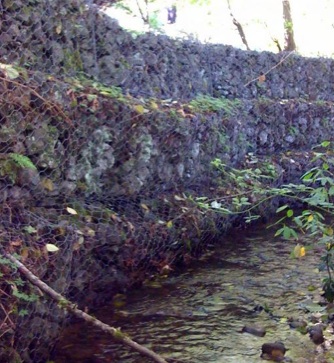 A gabion, which comes from the Latin cavea (meaning cage,) is essentially a cylinder, most often used in civil engineering, that is filled with rocks, concrete, sand and soil and built for the purpose of erosion control. This particular Gabion Wall's composition is a mixture of plastic, metal and stone. The wall is enclosed in mesh, which includes live plant stakes that will grow to form vegetation, making it appear "more natural than a cement wall" says Mr. DeGiorgio. However, the four-foot wall may initially appear to be an eyesore, as "it will take about a year for the foliage to fully grow along the wall." In terms of functionality, the wall will soften the current, steep vertical walls of the stream bank and turns in the watercourse will be removed. This would facilitate the brooks' flow through the woods, prevent further erosion of the stream bank and protect tree roots along the watercourse. According to D&B, this Gabion Wall has a "useful life of over 20 years" so "there is no reason why it wouldn't be there for quite some time." So while it is not a permanent fix, the Gabion Wall appears to be the best option for long-term erosion control.
A gabion, which comes from the Latin cavea (meaning cage,) is essentially a cylinder, most often used in civil engineering, that is filled with rocks, concrete, sand and soil and built for the purpose of erosion control. This particular Gabion Wall's composition is a mixture of plastic, metal and stone. The wall is enclosed in mesh, which includes live plant stakes that will grow to form vegetation, making it appear "more natural than a cement wall" says Mr. DeGiorgio. However, the four-foot wall may initially appear to be an eyesore, as "it will take about a year for the foliage to fully grow along the wall." In terms of functionality, the wall will soften the current, steep vertical walls of the stream bank and turns in the watercourse will be removed. This would facilitate the brooks' flow through the woods, prevent further erosion of the stream bank and protect tree roots along the watercourse. According to D&B, this Gabion Wall has a "useful life of over 20 years" so "there is no reason why it wouldn't be there for quite some time." So while it is not a permanent fix, the Gabion Wall appears to be the best option for long-term erosion control.
Another crucial aspect of this operation is removing trees that impede the flow of the stream. D&B has identified approximately 50 dead, fallen or endangered trees to remove. Though residents have expressed concerns about the removal of these trees, DeGiorgio said that Harcourt Woods is not being transformed into a detention pond like George Field and Cooper Green where there was massive tree removal. In this case, a few trees will be removed and replaced with new ones that don't impede stream flow. The revised project includes the planting of 28 new trees, along with dozens of shrubs, to replace what is removed.
This project is estimated to cost $1,000,000, a $50,000 increase from the prior proposal in October 2012 due to the difficulty of working in that area. "The space in Harcourt Woods is tight and the work is very labor intensive which increases the cost," says Rob DeGiorgio. This price increase is also due to the inclusion of tree and shrub planting, which was not in the original proposal but added after residents expressed concern about the potential loss of trees. Some also questioned the project from a cost/benefit perspective. Deb Pekarek wondered if it "would provide sufficient benefit to warrant the price tab." The cost of the project will be partially underwritten by a grant from Westchester County and construction is slated to begin this summer.
George Field and Cooper Green Projects Nearly Completed
- Details
- Hits: 5959
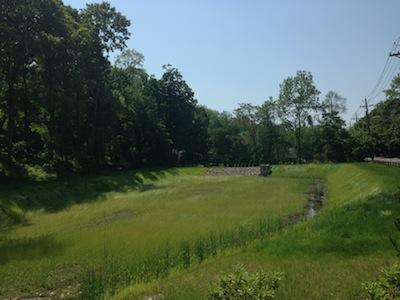
Happily, as the South Fox Meadow Improvement Project, nears completion, most agree that it is aesthetically pleasing and successful at gathering and moving water out of the area. The $3.1 million project included work at George Field Park (re-habilitated wetland and construction of a bio-detention basin), Cambridge Road (installation of catch basins), Cooper Green (construction of rain gardens and a bio-detention basin) and the open watercourse along Post Road (cleaning and stream restoration).
With the project in its final stages, nearby residents have noticed positive results. One Cambridge resident spoke on the projects effects on his area, "the new system has relieved flooding on Cambridge Road and had an even bigger impact on Greendale, Oxford and Windmill, which suffered previously." He also commented on how the new projects in his neighborhood look and have been received by the community, "Cooper Green looks fantastic – better than before... if you drive around you will notice new construction—a sure sign that people feel great about the situation and remediation efforts. The problem is solved." Another resident commented, "it's been raining all day and Oxford hasn't flooded, which is an improvement."
An Eton Road resident shared ideas that could improve the George Field project, "It would be better to look at if there were more shrubs, grasses and small trees planted, as on Cooper Green. At least they did not put in a cell tower...it will hopefully look better in a few years."
We also asked Assistant Village Manager John Goodwin for an update on the project and here is what he shared:
When is planting on George Field planned to take place?
The work at George Field Park is complete. The Village will consider additional landscaping for the project based on the successful achievement of 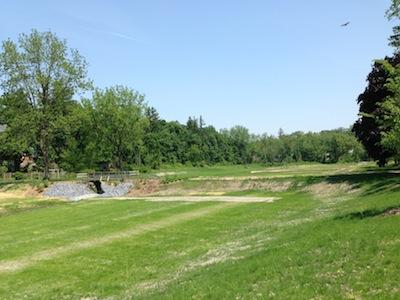
What has been the biggest rainfall in Scarsdale since the installation, and what effect did the new stormwater management system have?
I do not know the largest rainfall that Scarsdale has experienced since the detention basins were effectively completed and fully functional. With that said, I do not believe that any rain events have been greater than 2" in a 24 hour period. (The basins are designed to mitigate flooding in rain events that are 3.5" in a 24-hour period). Last Thursday/Friday (May 23 and May 24) the rain event was 1.64". For those rain events that have occurred, the basins have operated effectively.
Were there any issues or problems that came up during the planning or execution of the project that were not anticipated?
With all construction projects, unexpected field conditions and changes occur. During the planning stages of the project there were several issues that arose as detailed in the attached resolution. During the construction of the project changes had to be made to accommodate an unmapped residential sanitary sewer lateral pipe at Cooper Green; higher than anticipated ground water at George Field Park; and a redesign/alternation of the tree removal plan at George Field Park. None of the changes had a significant impact to the projects goals.
How much debris was removed from the George Field and Cooper Green areas during the process of the project?
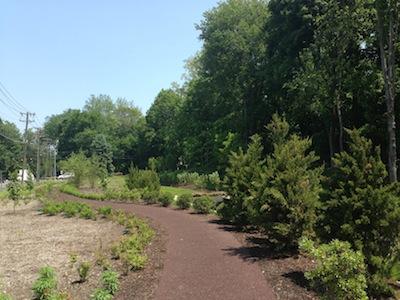
What has been the response of residents living near the project sites?
The Village has received many positive comments about the project from residents neighboring George Field Park and Cooper Green. Some residents have requested additional landscaping at both sites. See above.
When is the entire project expected to be fully functional?
The final administrative work to close -out both contracts is underway and there will be some additional signage, both directional and educational, placed at George Field Park. With the exception of the Harcourt Woods segment of the project, all segments are fully functional.
Given the scale of the project, have you received any inquiries concerning the project from neighboring communities hoping to implement a similar system?
The Westchester County Soil and Water Conservation Board has asked the Village staff to take them on a project site visit, which is scheduled for next month. The Village has not received any other inquiries from local governments, however it is expected that as time goes on and the benefits of the project can be observed, that neighboring communities may inquire.
The final segment of the project at Harcourt Woods was redesigned and is currently out to bid. It is anticipated that construction of the Harcourt Woods segment will start early this summer. A Municipal Services Committee meeting is scheduled for June 5th at 6:30 PM where a presentation will be given detailing the scope of work at Harcourt Woods.
This article was contributed by Brian Shabto, a senior at Scarsdale High School.
Do You Recognize This Dog?
- Details
- Hits: 4591
 This German Shepard was found wandering around Heathcote in Scarsdale on Wednesday. She has no tag or microchip and is currently being held at a veterinarian's office. The vet cannot hold her much longer, so please contact her owners if you recognize her. She is beautifully groomed and trained. Clearly she is someone's pet.
This German Shepard was found wandering around Heathcote in Scarsdale on Wednesday. She has no tag or microchip and is currently being held at a veterinarian's office. The vet cannot hold her much longer, so please contact her owners if you recognize her. She is beautifully groomed and trained. Clearly she is someone's pet.
Please contact (917) 202-6039 ito claim her.
Panelists Explore Signs of Dating Abuse
- Details
- Hits: 3545
 Scenario: You are walking down your street and in the distance, you see someone, a stranger, walking in your direction. You continue walking towards one another. You assume that he will walk passed you, and expect that the two of you won't share any sort of interaction, as this is what happens with most strangers. However, as he passes, you hear him mutter something extremely vulgar and disrespectful. You are offended, astounded, scared and angry. You turn around to strike back with a verbal assault of your own, but decide that escalating the conflict would be risky and immature. So instead, you begin walking away. Seconds later, you are struck in the head with a forceful punch. There is no one around to help you. You feel violated, victimized and abused. Would you allow this mad man to continue beating you, perhaps until you awake in a hospital bed? Or do you fight back, recognizing that you must protect yourself and achieve some sort of retribution?
Scenario: You are walking down your street and in the distance, you see someone, a stranger, walking in your direction. You continue walking towards one another. You assume that he will walk passed you, and expect that the two of you won't share any sort of interaction, as this is what happens with most strangers. However, as he passes, you hear him mutter something extremely vulgar and disrespectful. You are offended, astounded, scared and angry. You turn around to strike back with a verbal assault of your own, but decide that escalating the conflict would be risky and immature. So instead, you begin walking away. Seconds later, you are struck in the head with a forceful punch. There is no one around to help you. You feel violated, victimized and abused. Would you allow this mad man to continue beating you, perhaps until you awake in a hospital bed? Or do you fight back, recognizing that you must protect yourself and achieve some sort of retribution?
Most people would agree that being abused, in any form; by another person is immoral, illegal and completely unacceptable. And most people believe that if they found themselves in a situation where they were being or had been abused, they would find a way to stop the abuse and seek proper retribution.
In the fictional scenario above, someone was violently assaulted by a complete stranger. That is an obvious form of abuse, and would be recognized as such by all parties involved, both internal and external.
But what if the abuse occurs within a "loving" relationship? What if the abuser is a boyfriend, girlfriend or significant other? How can you recognize abuse when you have an affinity for the abuser?
Danielle DeZao knows firsthand about the ambiguous, discreet nature of dating abuse. After entering one of her first dating relationships at Marist College, she felt all the initial excitement of attraction. However, soon that thrill collapsed into verbal fights, control over her activities, and eventually physical abuse.
Danielle and her mother Denise shared their story May 22nd at the Scarsdale Woman's Club as part of the Love Shouldn't Hurt campaign, a program designed to inform parents about dating abuse, and to arm them with knowledge to help their own children when it comes to dating and healthy relationships. Danielle and Denise were joined by a panel which included:
- Lauren Pomertantz, Scarsdale High School Youth Outreach Worker
- Sharon Charles, Youth Counselor with Westchester Jewish Community Services
- Detective Sherri Albano, Youth Officer of the of the Scarsdale Police Department
- Amy Paulin, New York State Assemblywoman
- Chris D'Silva, Leader of the SHS Chapter of Terminating Abusive Relationships
The panel was sponsored by The Scarsdale Coalition on Family Violence.
The abuse that occurs within a dating relationship takes on a very different form than the fictional scenario described above. "Abusive relationships... start slowly and gradually progress towards utter chaos," says Danielle.
Teen dating abuse will likely start out similar to any other relationship. It begins with perfection, laughter, and all of the exciting things that come with new love and new beginnings," says Danielle.
However, once the initial honeymoon phase starts to wear off "within a couple months," the initial stages of abuse begin. This abuse often takes discreet forms like jealousy. These types of seemingly harmless relational features are often deemed by society as a normal part of relationships, and thus do not receive the attention and concern they ought to warrant.
A common scenario in the initial stage of dating abuse is a boyfriend who becomes jealous when his girlfriend talks to another guy. This jealously eventually escalates to more serious stages where the boyfriend becomes possessive and controlling. For Danielle, her boyfriend was soon "telling her who to hang out with and what to wear." This brings up another warning sign of dating abuse: isolation. Danielle's boyfriend isolated her from her friends and family, claiming he was "trying to "save" her from everything else in her life" when in reality, he was the one "who was hurting her the most."
And while dating abuse may not start out as abrupt and violent as in the first scenario described, it can certainly escalate to that level if left to naturally progress. And for Danielle, that is exactly what happened. She found herself constantly "using make-up to cover her bruises" and "thinking of new ways to hide the different marks on her body."
Considering the initial argument that most people wouldn't willingly tolerate abuse from someone if they had the power to stop it, it would seem logical that anyone involved in a relationship like this would simply end it and cease the abuse. But when dating and "love" are involved, it becomes much more complex than that.
First off, it is often hard for someone to know when he or she is in an abusive relationship. "Abusers don't walk around with red X's on their forehead. They are regular people who are excellent at concealing their motives," says Danielle.
Often times, the abuse is well disguised as a mere product of genuine, passionate love. Or maybe the abused party is so infatuated with certain aspects (appearances, money, etc) of their partner that they are wiling to put up with "abuse" and consider it a minor detail. They rationalize warning signs like overt possessiveness, claiming, "It's just because he cares about me."
Many victims, like Danielle, remained attached to their abuser despite mistreatment. They endure the "endless promises that he didn't mean it, that it will never happen again." They don't want to end the relationship because they genuinely "believe it will change," that they "can make it change." They end up trapped "in a vicious cycle of dreamy, fleeting happiness."
Dating abuse is a very distinct and difficult type of abuse to prevent, mainly because the abused party is often unaware, or does not want to believe that she (90-95% of dating violence is perpetrated by men and done to women) is being abused. She will try to "justify the seemingly pointless arguments by saying it's still a relatively new relationship, and that trust issues are normal."
With courage, honesty and the support of her family, Danielle was able to escape her situation before it gravely damaged her life. She is "thankful she survived." Many teens however, have not been as fortunate. In recent events, two 16-year-old boys raped a young girl, and the girl was actually blamed by her peers and received no empathy from the national media. In other recent news, a Virginia lacrosse player was beaten to death by her boyfriend.
One in three teens is involved in an abusive relationship. According to Reverend Dr. John Miller of Hitchcock Presbyterian Church, "We need to create a community of respect for our children so that they understand what healthy relationships look like and feel like. At the same time parents need to be educated about the danger signs of unhealthy and dangerous relationships and given tools on how to discuss these sensitive issues with their children."
Trustees and Residents Review Stormwater Mitigation Plans for Heathcote
- Details
- Hits: 4274
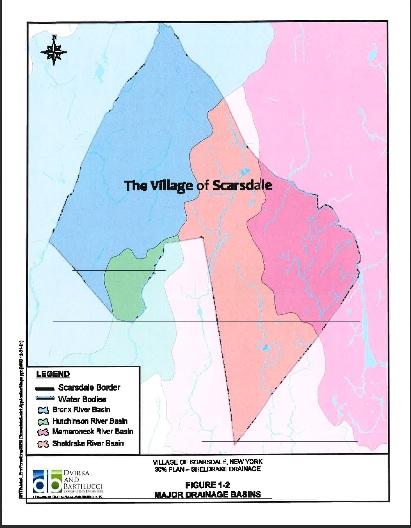 According to Seneca Road resident Neil Tucker, "when you're facing a potential flood on your property, every day is a bad day." Tucker and his neighbors were at Village Hall on May 14 to hear a third proposal from Robert DeGiorgio of Dvirka and Bartilucci Engineers on how to mitigate flooding in the Sheldrake River Basin near Fenway Golf Club.
According to Seneca Road resident Neil Tucker, "when you're facing a potential flood on your property, every day is a bad day." Tucker and his neighbors were at Village Hall on May 14 to hear a third proposal from Robert DeGiorgio of Dvirka and Bartilucci Engineers on how to mitigate flooding in the Sheldrake River Basin near Fenway Golf Club.
This most recent proposal focuses on improving water flow from Cayuga Pond into the open watercourses along Cayuga and Canterbury Roads to the culvert at Canterbury Road. Cayuga Pond would be converted from a recreational pond into a storm water detention basin to manage excess stormwater runoff. This conversion will allow the pond to retain water during heavy downfalls and to release it slowly over time. Engineers also proposed the removal of accumulated silt and debris from the pond that now prevents maximum water retention. This, along with a modification to the spillway, will create 11 acre-feet of storage in the pond, which allows for the collection of three million gallons of water. Another crucial aspect of this modified plan is improvement of the culverts (drain pipes that allow water to flow under roads) on Cayuga and Canterbury Road. These improved culverts would allow for better water flow and balance through the piping systems.
The overall benefits from this plan are:
• A reduction in flooding impact across the entire Sheldrake flood plain during storm events
• Proportionate mitigation in high intensity events
• Reduction and staggering of peak water run off rates
• Ease of culvert maintenance and observation
• Elimination of outflow from Cayuga pond in less intense storm events
• Significant improvements to channelization of water flow
The Village first retained engineers Dvirka and Bartilucci (D&B) in 2004 following a Storm Water Drainage Condition Survey. They were asked to address storm water issues in the Sheldrake River Basin which extends from Cushman and Sheldrake Roads to Fenway Golf Course flowing down to the Scarsdale Middle School, onto the Scarsdale Medical Center and into New Rochelle.
In order to mitigate flooding upstream, D& B formulated the 2009 Comprehensive Stormwater Management Plan, which proposed certain modifications to the current drainage structure. The modifications primarily focused on improving the Sheldrake River Drainage Basin and reducing the excessive water runoffs during precipitation-heavy storms that cause devastating flooding for Scarsdale residents in these flood-prone areas.
The 2009 plan identified six critical sub-drainage areas, three of which were within the Sheldrake Drainage Basin. These three areas, labeled "SR 2", "SR 3" and "SR 5" correspond to the Garden Road Area, the Fenway Golf Club Area, and the Brookby Road Area, all of which have their own distinct flooding issues. The low-lying portions of these areas, such as the Fenway Golf Club area, have been designated as FEMA Flood Plains and homes in this area have been damaged during major storm events. During a storm in September, 2011 several homes in this area were inundated and residents have been awaiting a solution ever since.
Much of the improvement plan needs to be implemented on private property and restrictive deeds and covenants obligate the homeowners to underwrite a portion of the project. The Village is proposing that the 19 homeowners whose homes border the pond or waterway foot the cost for the work to the pond and watercourse. The total cost is estimated at $1,195,00 and the Village would assume 86% of the cost or $1,030,000, and apply for government grants to fund it. The 19 affected homeowners would pay the remaining 14% or $166,000 with the seven who live around the pond bearing the responsibility for $108,000 of the $166,000 tab. The Village would create a special benefit district and property owners could pay for the project over a twenty-year period. Following the project, homeowners would be responsible for maintaining the pond and the village would maintain the open watercourse. According to Rob DeGiorgio the maintenance is "the most critical aspect of storm water management." Residents could either hire their own contractors to remove the silt or the Scarsdale Department of Public Works could handle it and add the cost to the resident's tax bills. The Village hoped to have agreements in place by September 1, 2013 and have the work done in 2014-15.
However, the residents who attended the meeting questioned whether all of the homeowners bordering the pond would be willing to share in the cost and also speculated on the ability of the plan to relieve flooding. They feared that those who were not affected by the flooding, would not contribute. Alissa Kanowitz of Seneca Road said, "It is difficult to persuade homeowners. It is only natural that you are going to have some disgruntled residents when you knock on their door and tell them that we are converting your pond to a drainage facility, and oh, by the way, you owe $18,000." According to Doug Ulene, who also lives around the pond, this scenario has essentially "pitted neighbor against neighbor." After years of watching water engulf his neighborhood he has become something of an expert on Scarsdale's water problems. According to Ulene "In a perfect world, the Village would enlarge all of its stormwater infrastructure. That's an expensive proposition and the process would be complicated because of the potential impact on downstream communities." Assuming that the village will take a more measured approach, Ulene encouraged them to "focus on projects that improve outflow," such as "making culverts, and other locations that become clogged, easier to clean." Because "there is a limit on the amount of water any area can hold, it's best to make sure that the water leaves as quickly as possible."
Though the deed to the properties around the pond require the homeowners to maintain the pond, Ulene contends that the Village is "privatizing a quintessentially government function." Saying that residents "don't rely on their neighbors for gas, electricity, water, sanitary sewers and telephone service" he questions why the Village left this flooding issue up to residents to solve.
Homeowners at the meeting also noted that the water level in the pond has already dropped – due to the fact that the spillway is locked in the open position. They argued that it might not be necessary to de-silt the pond and proposed that if the Village fixed the spillway and culverts and cleaned the watercourse it would clear up "90% of the problem."
Robert DeGiorgio responded by saying "I wish there was an easy solution," but told the group that "it is dead flat from the pond to the watercourse," and therefore improving the flow would not be simple.
Frustrated with the lack of progress, Tucker said, "Cayuga residents want to get the water out of their neighborhood." Richard Kanowitz said, "in a large storm or snow melt, I could kiss my house goodbye."
At the conclusion of the meeting Alissa Kanowitz asked if the Village could establish a working committee with residents and "not wait another six months for the next meeting. Mayor Steves said "I will commit to a schedule that will move this along and take this to a logical conclusion as quickly as we can." Village Manager Al Gatta asked the residents to "tell us what is adequate so that we can move forward. If we fix the culverts and it works, Mr. Kanowitz will be crowned for being right."













